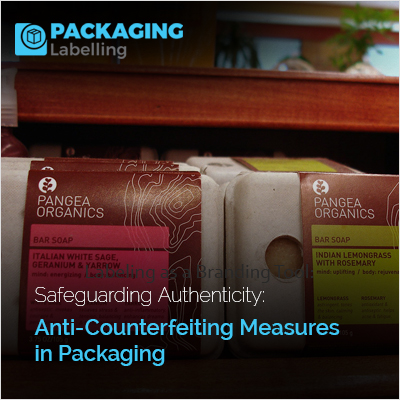Safeguarding Authenticity: Anti-Counterfeiting Measures in Packaging

In a time characterized by technological progress and widespread global trade, the menace of counterfeiting has grown substantially, presenting substantial dangers to consumers, enterprises, and global economies. To address this challenge, the packaging industry has embraced cutting-edge anti-counterfeiting measures to guarantee the genuineness of products and safeguard brand reputation. This article delves into the diverse strategies and technologies implemented in packaging to counteract counterfeiting.
Strategies and technologies to prevent counterfeiting through packaging
Holographic and Tamper-Evident Packaging
Implementing holographic and tamper-evident packaging strategies is a pivotal approach to combat counterfeiting. Holographic packaging involves the use of three-dimensional images or patterns that are challenging to replicate, serving as a visible and distinctive authentication feature. This not only enhances the aesthetics of the packaging but also provides a secure and recognizable element that consumers can easily identify. Tamper-evident packaging, on the other hand, incorporates features that make it evident if the package has been opened or compromised.
Technologies such as seals, tapes, or labels that are designed to break or show irreparable damage upon tampering serve as clear indicators of product integrity. These measures not only act as a deterrent to counterfeiters but also instill confidence in consumers by ensuring the authenticity and safety of the product. By combining holographic and tamper-evident packaging, companies can create a multi-layered defense against counterfeiting, safeguarding both their brand reputation and consumer trust.
QR Codes and Unique Identification
In the ongoing battle against counterfeiting, the integration of QR codes and unique identification technologies within packaging emerges as a robust strategy. QR codes enable a quick and efficient means of product authentication, allowing consumers to scan the code with their smartphones to verify the product's legitimacy. These codes can link to a secure database, providing real-time information on the product's origin, manufacturing details, and distribution history.
Simultaneously, unique identification features, such as serialized numbers or barcodes, offer each product an individualized identity. This uniqueness not only aids in tracking and traceability but also acts as a deterrent to counterfeiters attempting mass replication. The combination of QR codes and unique identification thus empowers both consumers and supply chain stakeholders with the tools to easily authenticate products, fostering transparency and trust while creating a formidable barrier against the proliferation of counterfeit goods.
RFID Technology
Employing Radio-Frequency Identification (RFID) technology is a cutting-edge and effective strategy in the ongoing effort to prevent counterfeiting through packaging. RFID involves the use of small electronic devices, often embedded in tags or labels that emit radio waves to identify and track products. These RFID tags store unique information about each item, such as its origin, manufacturing date, and route through the supply chain. By integrating RFID into packaging, companies can establish a comprehensive and real-time monitoring system. This not only facilitates rapid and accurate product authentication but also enables seamless inventory management and supply chain visibility.
Additionally, RFID offers a higher level of security as the information stored on the tags is more challenging to alter or replicate compared to traditional barcodes. Implementing RFID technology in packaging thus presents a sophisticated and efficient means of safeguarding against counterfeiting while enhancing overall operational efficiency and consumer confidence.
Nano-Ink and Microprinting
In the effort to combat counterfeiting through packaging, the adoption of nano-ink and microprinting stands out as an advanced and intricate approach. Nano-ink entails the utilization of exceedingly small particles, typically at the nanoscale, possessing distinctive optical properties that render them difficult to duplicate. This technology facilitates the development of intricate and imperceptible markings on packaging, detectable only through specialized tools designed for authentication.
Microprinting, on the other hand, involves the application of exceptionally small text or patterns that are not easily visible to the naked eye. These microscopic details can include logos, serial numbers, or other identifiers that are difficult to reproduce accurately. By combining nano-ink and microprinting, packaging gains an additional layer of covert security, as counterfeiters are faced with the formidable task of replicating these minuscule and intricate features.
This sophisticated technology not only elevates the overall sophistication of anti-counterfeiting measures but also offers an efficient way to guarantee the authenticity of products. In doing so, it plays a crucial role in protecting brand reputation and fostering consumer trust.
Digital Watermarking
Integrating digital watermarking into packaging represents a sophisticated and covert strategy to combat counterfeiting. Digital watermarking involves the embedding of imperceptible digital codes or patterns within images or text on the packaging. These watermarks serve as unique identifiers that can be authenticated using specialized scanning devices or smartphone apps.
Unlike visible holograms or labels, digital watermarks are discreet and not easily detectable by counterfeiters, providing an added layer of security. This technology allows manufacturers to encode essential information such as product origin, batch numbers, or authenticity verification directly into the packaging.
As a result, consumers and supply chain stakeholders can easily validate the product's legitimacy by scanning the digital watermark. The implementation of digital watermarking not only acts as a powerful deterrent against counterfeiting but also enhances traceability and transparency throughout the product lifecycle, contributing to the overall integrity of the supply chain.
Blockchain Technology
The utilization of blockchain technology in packaging represents a revolutionary approach in the battle against counterfeiting. Blockchain, characterized by its decentralized and tamper-resistant digital ledger, establishes an unalterable record of transactions and the journey of products throughout the supply chain. When integrated into packaging, blockchain assigns a distinctive and encrypted digital identity to each product, enabling transparent and traceable information from manufacturing through distribution to retail. This guarantees an uninterrupted chain of custody, significantly raising the hurdles for counterfeiters attempting to replicate or manipulate information.
Consumers can access this decentralized ledger through QR codes or other scanning methods, verifying the authenticity and provenance of the product in real-time. Blockchain not only enhances security but also fosters trust by providing a verifiable and transparent system for stakeholders.
The technology's decentralized nature and cryptographic security make it a robust solution, reinforcing brand integrity, consumer confidence, and supply chain resilience against the persistent threat of counterfeiting.
By combining these strategies, B2B businesses can create a more resilient and secure supply chain, safeguarding their brand and products from various risks and ensuring a consistent level of quality and authenticity.









